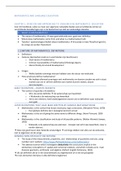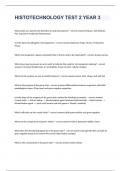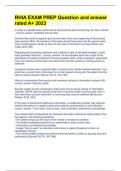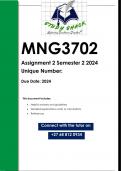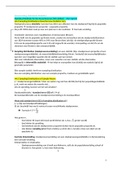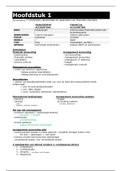CHAPTER 1: VIEWS ON AND APPROACHES TO (RESEARCH IN) MATHEMATICS EDUCATION
Voor dit hoofdstuk, zullen ze meer een algemene reikwijdte bieden wat verschillende zichten en
verschillende benaderingen zijn in de basisschool op vlak van wiskundige educatie.
1. WHAT IS MATHEMATICS?
• The nature of mathematics → waar gaat wiskunde over, gaat over definities
• Where does mathematics come from and what is a mathematical truth
• Teachers’ epistemological beliefs about mathematics → dit puntje is meer filosofisch gericht,
de vorige zijn eerder theoretisch
1.1 NATURE OF MATHEMATICS: DEFINITIONS
• Definitions
• Features (kenmerken zoals ze in veel teksten zijn beschreven)
o Dual nature of mathematics
o Intrinsic inaccessibility of mathematical (thinking) objects
o Hierarchically structured development
• Images
o Welke beelden sommige mensen hebben over de natuur van wiskunde
• How would you define mathematics?
• We hebben allemaal ervaringen met mathematics en daarom zouden we ook in staat
moeten zijn om er zelf een definitie van moeten kunnen maken, alsook
kernconcepten
EARLY DEFINITION – OUDSTE DEFINITIE
• The science of quantity ( Aristoteles)
o Dit is de eerste definitie → de wetenschap van kwantiteit
o = Wiskunde is de wetenschap van kwantiteit
o Het is een element, heel brede/algemene manier om te definiëren waar wiskunde
over gaat
LATER DEFINITIONS THAT HAVE BEEN WRITTEN BY FAMOUS MATHEMATICENZ
• Mathematics is the science that draws necessary, logic conclusions. (Benjamin Peirce, 1870)
o Heel globale definitie dat 1 belangrijk kenmerk omvat
• Mathematics is the art of giving the same name to different things. (Henri Poincaré, 1850-
1912)
• Mathematics is the classification and study of all possible patterns. (Walter Warwick Sawyer,
1955)
o Wiskunde is de wetenschap van patronen - Verwijst niet echt naar kwantiteit, maar is
eerder abstract
→ Deze zijn geschreven door bekende wiskundigen → sommige dekken niet alles van de wiskunde,
niet zo algemeen als de vorige
GENERAL NON-SPECIALIST DEFINITIONS
• The study of the measurement, properties, and relationships of quantities and sets, using
numbers and symbols. (http://www.thefreedictionary.com/mathematics)
• The abstract science which investigates deductively the conclusions implicit in the
elementary conceptions of spatial and numerical relations, and which includes as its main
divisions geometry, arithmetic, and algebra. (Oxford English Dictionary, 1933)
→ dit zijn definities die je in een woordenboek zou tegenkomen of in een encyclopedie
→er zijn elementen die bijna in elke definitie terugkomen
, • The science of structure, order, and relation that has evolved from elemental practices of
counting, measuring, and describing the shapes of objects. (Encyclopaedia Britannica)
o Dit gaat over de geschiedenis van wiskunde, waar het vandaan komt
• Mathematics is a broad-ranging field of study in which the properties and interactions of
idealized objects are examined. (Wolfram MathWorld)
DEFINITION BY WIKIPEDIA
Mathematics (from Greek μάθημα máthēma, “knowledge, study, learning”) is the study of topics
such as quantity, structure, space, and change. There is a range of views among mathematicians
andphilosophers as to the exact scope and definition of mathematics.
Mathematicians seek out patterns and use them to formulate new conjectures. Mathematicians
resolve the truth or falsity of conjectures by mathematical proof. When mathematical structures are
good models of real phenomena, then mathematical reasoning can provide insight or predictions
about nature. Through the use of abstraction and logic, mathematics developed from counting,
calculation, measurement, and the systematic study of the shapes and motions of physical objects.
Practical mathematics has been a human activity for as far back as written records exist. The
research required to solve mathematical problems can take years or even centuries of sustained
inquiry. (…)
• Bij deze definitie zijn er meerdere definities bij elkaar gezet
• Veel elementen die in de vorige definities stonden, worden hier ook samengebracht
DEFINITION BY COURANT & ROBINS – BOOK: ‘WHAT IS MATHEMATICS?’
Mathematics as an expression of the human mind, expresses the active will, the contemplative
reason, and the desire for aesthetic perfection. Its basic elements are logic and intuition, analysis and
construction, generality and individuality.
Though different traditions may emphasize different aspects, it is only the interplay of these
antithetic forces and the struggle for their synthesis that constitute the life, usefulness and supreme
value of mathematical science.
Without doubt, all mathematical development has its psychological roots in more or less practical
requirements. But once started under the pressure of necessary application, it inevitably gains
momentum in itself and transcends the confines of immediate utility. This trend from applied to
theoretical science appears in ancient history as well as in many contributions to modern
mathematics by engeneers and physicists.
• Ze proberen uit te leggen wat wiskunde is in dit boek
1.1 NATURE OF MATHEMATICS: FEATURES
Features → 3 belangrijke kenmerken van wiskunde, three important features
o Dual nature of mathematics
o Intrinsic inaccessibility of mathematical (thinking) objects
o Hierarchically structured development
Images
DUAL NATURE OF MATHEMATICS
• “On the one hand, mathematics is rooted in the perception and description of the ordering
of events in time and the arrangement of objects in space and the solution of practical
problems.
o Wiskunde ligt geworteld in de praktische oplossingen waarmee we elke dag
geconfronteerd worden
o Dit gaat over het theoretische en pure kant van wiskunde = de ene kant
o We worden ermee geconfronteerd in ons dagelijkse leven
• On the other hand, out of this activity emerge symbolically represented structures that can
become objects of reflection and elaboration, independent of their real-world roots. (…)
1
, o We hebben ook de toegepaste kant van wiskunde = de andere kant
o Je kunt niet begrijpen wat wiskunde is als je niet erkent dat het ook zijn pure kant
heeft. Dat als je eens op een probleem stuit dat vraagt om wiskundige oplossingen
binnen de discipline van wiskunde, zal je bepaalde concepten creëren waarop je zal
reflecteren zonder consideratie over de concrete praktische problemen en zonder te
overwegen welke mogelijke toepassingen uw puur mathematisch denken heeft.
• This duality is acknowledged in the distinction between the pure and applied mathematics.”
INTRINSIC INACCESSIBILITY OF MATHEMATICS
• There is the intrinsic inaccessibility of mathematical (thinking) objects (Duval, 2002), implying
that their conceptual acquisition necessarily passes through the acquisition of one or more
semiotic representations (verbal, symbolic, visual, auditory, tactile, etc.)
o Bij biologie of muziek heb je directe toegang tot het object van de studie. Je kunt het
zien, horen, aanraken,.. → bij wiskunde is dat niet, object van studie is nooit
toegangbaar door perceptuele zintuigen. Het is alleen toegangbaar door
representaties (= indirect access)
• The development of mathematics is inextractably dependent on systems of symbols and
graphical means of envisioning information (e.g., the Arabic place-value system compared to
the Roman system)
• Multiplying in Roman vs. Arabic number system: what works best?
o We gebruiken verschillende soorten om te rekenen, maar als je du seen ander
representationeel domein gebruikt is dit veel moeilijker
➔ We gebruiken een bepaald representationeel systeem voor bv. vermenigvuldigingen
➔ Vroeger gebruikte men andere representationele systemen: romeinse cijfers
➔ Die representaties zijn heel belangrijk in het mathematisch denken
• And in the binary number system: what works best?
➔ We gaan het arabische nummersysteem vergelijken met het binaire nummersysteem
➔ Het zijn dezelfde nummers, maar het laatste systeem gebruikt enkel 0 en 1.
➔ Wat is het voordeel van het binaire systeem? Het laat toe dat je toepassingen in de
technologie kunt doen. We kunnen mathematisch denken linken aan de ontwikkeling van
computerwetenschappen = close link between the binarity and the implementation of the
computer sciences
HIERARCHICALLY STRUCTURED DEVELOPMENT
• Both the history of mathematics as a cultural development (phylogeny -the culture
development of mankind) and an individual child’s mathematical development (ontogeny)
can be conceived in terms of various types and levels of representations which build on one
other as the mathematical ideas become more abstract.
2
, o In elke nieuwe ontwikkelingsstap, wordt het denken altijd meer abstract, meer
algemeen over het denken van een individu of een maatschappij
o Je kan mathematische ontwikkeling karakteriseren in termen van het toenemen in
verschillende lagen → meer abstractie in het denken van het individu
EXAMPLE OF THE HIERARCHICALLY STRUCTURED DEVELOPMENT OF MATH
➔ Het gaat over het nummersysteem
➔ Verschillende types van nummers, en elke nieuw type nummer dat geïntroduceerd wordt is
telkens meer abstract
➔ Er komt elke keer een nieuwe conceptuele stap en wordt het dus meer ingewikkeld
➔ Er is een hiërarchische structuur in de ontwikkeling van het mathematisch denken
1.1 NATURE OF MATHEMATICS: IMAGES
• Technische tools hebben veel wiskundig denken nodig, dat staat dan ook op de cover
• Hoe de voorpagina van een encyclopedie (meer specifiek het deel dat aan wiskunde is
toegewijd) ontwikkeld is over verschillende decenia
• Hoe hebben ze geprobeerd om een beeld te creëren over waar wiskunde over gaat?
• Foto’s van mensen die wiskunde doen, foto’s van bekende wiskundigen
• Ontwerpen brengt ook bepaalde prestaties in beeld, het sociale leven (pyramides),
vliegtuigen,… ze verwijzen ook naar typische wiskundige objecten bv. rekenmachines,
vendiagrammen
• Hoe interessant het kan zijn welke mentale beelden mensen van wiskunde hebben en hoe
dat doorheen de jaren ontwikkelt is
3

